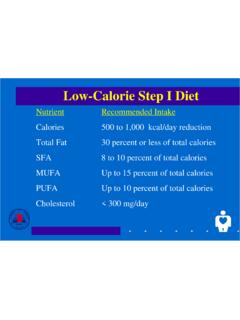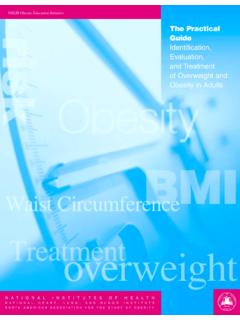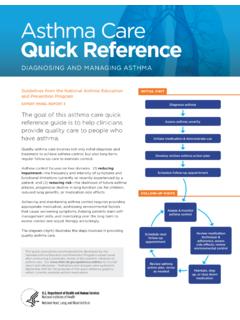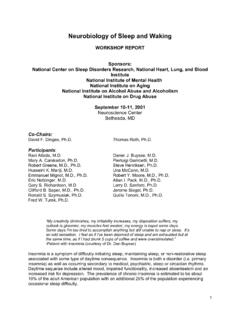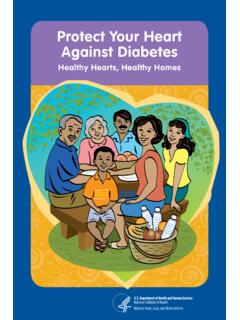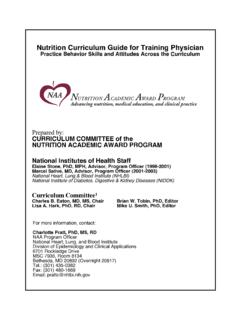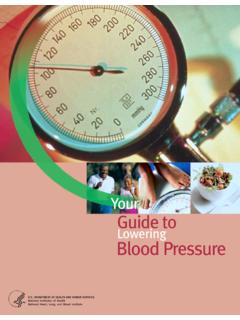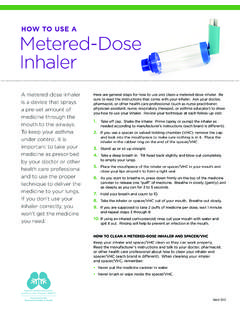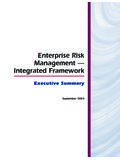Transcription of High Blood Cholesterol Summary - NHLBI, NIH
1 AThird report of theNational CholesterolEducation Program (NCEP)Expert Panel onDetection,Evaluation, and Treatmentof High BloodCholesterol in Adults (Adult TreatmentPanel III) executive Summary High Blood CholesterolEvaluationTreatmentDetectionN ATIONAL INSTITUTES OF HEALTHNATIONAL HEART, LUNG, AND Blood INSTITUTEN ational Cholesterol Education ProgramBDiscrimination Prohibited: Under provisions ofapplicable public laws enacted by Congress since1964, no person in the United States shall, on thegrounds of race, color, national origin, handicap,or age, be excluded from participation in, bedenied the benefits of, or be subjected to discrimi-nation under any program or activity (or, on thebasis of sex, with respect to any education programor activity) receiving Federal financial assistance.
2 In addition, executive Order 11141 prohibits discrimination on the basis of age by contractorsand subcontractors in the performance of Federalcontracts, and executive Order 11246 states thatno federally funded contractor may discriminateagainst any employee or applicant for employmentbecause of race, color, religion, sex, or national origin. Therefore, the National Heart, Lung, andBlood Institute must be operated in compliancewith these laws and executive report of the National Cholesterol Education Program (NCEP)Expert Panel onDetection, Evaluation, and Treatmentof High Blood Cholesterol in Adults (Adult TreatmentPanel III) executive Summary National Cholesterol Education ProgramNational Heart, Lung, and Blood InstituteNational Institutes of HealthNIH Publication No.
3 01-3670 May 2001 EvaluationTreatmentDetectionHigh Blood CholesteroliAcknowledgementsNational Cholesterol Education Program Expert Panel on Detection, Evaluation, andTreatment of High Blood Cholesterol in Adults (Adult Treatment Panel III)Members:Scott M. Grundy, , Chair of the PanelDiane Becker, , , Luther T. Clark, Richard S. Cooper, A. Denke, Wm. James Howard, B. Hunninghake, Roger Illingworth, , V. Luepker, , Patrick McBride, , James M. McKenney, Richard C. Pasternak, , Neil J. Stone, Linda Van Horn, , Members:H. Bryan Brewer, Jr., James I. Cleeman, executive Director of the PanelNancy D. Ernst, , David Gordon, , Daniel Levy, Basil Rifkind, E.
4 Rossouw, Peter Savage, :Steven M. Haffner, David G. Orloff, Michael A. Proschan, J. Sanford Schwartz, Christopher T. Sempos, :Susan T. Shero, , Z. MurrayExecutive Committee Liaison and Reviewers of the Full ReportExecutive Committee Liaison to the Panel:Stephen Havas, , , of the Full report of ATP III:Eugene Braunwald, , W. Virgil Brown, , Alan Chait, , James E. Dalen, , Valentin Fuster, , , Henry N. Ginsberg, ,Antonio M. Gotto, , , Ronald M. Krauss, , John C. LaRosa, , , Thomas H. Lee, Jr., ,Linda Meyers, , Michael Newman, , Thomas Pearson, , ,Daniel J. Rader, , Frank M. Sacks, , Ernst J. Schaefer, ,Sheldon G. Sheps, , Lynn A. Smaha, , , Sidney C.
5 Smith, Jr., , Jeremiah Stamler, , Daniel Steinberg, , , Nanette K. Wenger, Cholesterol Education Program Coordinating CommitteeTheThird report of the National Cholesterol Education Expert Panel onDetection, Evaluation, and Treatment of High Blood Cholesterol in Adultswasapproved by the National Cholesterol Education Program Coordinating Committee,which comprises the following organizational representatives:Member OrganizationsNational Heart, Lung, and Blood Institute Claude Lenfant, (Chair) James I. Cleeman, (Coordinator) American Academy of Family PhysiciansTheodore G. Ganiats, Academy of Insurance Medicine Gary Graham, Academy of Pediatrics Ronald E. Kleinman, Association of Occupational Health Nurses Pamela Hixon, , , College of Cardiology Richard C.
6 Pasternak, , American College of Chest Physicians Gerald T. Gau, American College of Nutrition Harry Preuss, American College of Obstetricians and Gynecologists Thomas C. Peng, American College of Occupational and Environmental Medicine Ruth Ann Jordan, American College of Preventive Medicine Lewis H. Kuller, , American Diabetes Association, Inc. Alan J. Garber, , iiiiiAmerican Dietetic Association Linda Van Horn, , Heart Association Scott M. Grundy, , Hospital Association Sandra Cornett, , American Medical Association Yank D. Coble, Jr., Nurses AssociationTo be namedAmerican Osteopathic Association Michael Clearfield, Pharmaceutical Association James M.
7 McKenney, Public Health Association Stephen Havas, , , Red CrossDonald Vardell, Association of Black Cardiologists Karol Watson, , of State and Territorial Health Officials Joanne Mitten, for Public Action on Blood Pressure and Cholesterol , Inc. Gerald J. Wilson, , Black Nurses Association, Inc. Linda Burnes-Bolton, , , , National Medical Association Luther T. Clark, Society for Nutrition Education Darlene Lansing, , Society for Public Health Education Donald O. Fedder, , Member OrganizationAmerican Association of Office Nurses Joyce LoganFederal Agencies NHLBI Ad Hoc Committee on Minority Populations Yvonne L. Bronner, , , for Healthcare Research and Quality Francis D.
8 Chesley, Jr., for Disease Control and Prevention Wayne Giles, , Committee for the Community Demonstration Studies Thomas M. Lasater, of Agriculture Alanna Moshfegh, , of Defense Col. Robert Dana Bradshaw, , and Drug Administration Elizabeth Yetley, Resources and Services Administration Celia Hayes, , Cancer Institute Carolyn Clifford, Center for Health Statistics Clifford Johnson, of Disease Prevention and Health Promotion Elizabeth Castro, of Veterans Affairs Pamela Steele, Cholesterol : The Primary Target of TherapyRisk Assessment: First Step in Risk ManagementMethod of risk assessment: counting major risk factors and estimating 10-year CHD risk Role of other risk factors in risk assessmentMetabolic syndrome The link between risk assessment and cost effectiveness Primary Prevention With LDL-Lowering TherapySecondary Prevention With LDL-Lowering TherapyLDL-Lowering Therapy in Three Risk CategoriesCHD and CHD risk equivalents Multiple (2+) risk factors and 10-year risk 20%Zero to one risk factor Therapeutic Lifestyle Changes in LDL-Lowering TherapyDrug Therapy to Achieve LDL- Cholesterol GoalsSecondary prevention: drug therapy for CHD and CHD risk equivalents LDL-lowering drug therapy for primary prevention Benefit Beyond LDL Lowering.
9 The MetabolicSyndrome as a Secondary Target of TherapyManagement of underlying causes of the metabolic syndrome Specific Treatment of Lipid and Non-Lipid Risk Factors Special IssuesManagement of Specific Dyslipidemias Special Considerations for Different Population Groups Adherence to LDL-Lowering Therapy AppendixShared Features of ATP III and ATP IIEstimating 10-Year Risk for Men and Women112245566778910101214141516 1717172022242425 ContentsviThird report of the National Cholesterol Education Program(NCEP) Expert Panel on Detection, Evaluation, and Treatment ofHigh Blood Cholesterol in Adults (Adult Treatment Panel III) executive SummaryIntroductionThe Third report of the Expert Panel on Detection, Evaluation, andTreatment of High Blood Cholesterol in Adults (Adult Treatment Panel III,or ATP III) constitutes the National Cholesterol Education Program s(NCEP s) updated clinical guidelines for Cholesterol testing and manage-ment.
10 The full ATP III document is an evidence-based and extensively referenced report that provides the scientific rationale for the recommen-dations contained in the executive Summary . ATP III builds on previousATP reports and expands the indications for intensive Cholesterol -loweringtherapy in clinical practice. It should be noted that these guidelines areintended to inform, not replace, the physician s clinical judgment, whichmust ultimately determine the appropriate treatment for each third ATP report updates the existing recommendations for clinicalmanagement of high Blood Cholesterol . The NCEP periodically producesATP clinical updates as warranted by advances in the science of cholesterolmanagement.

